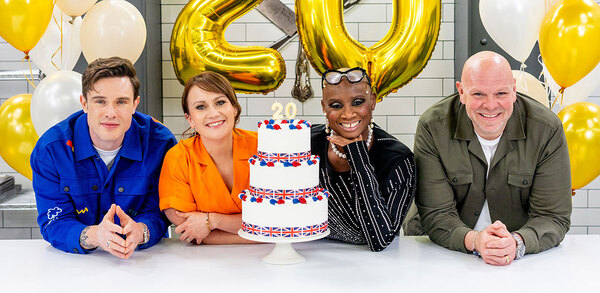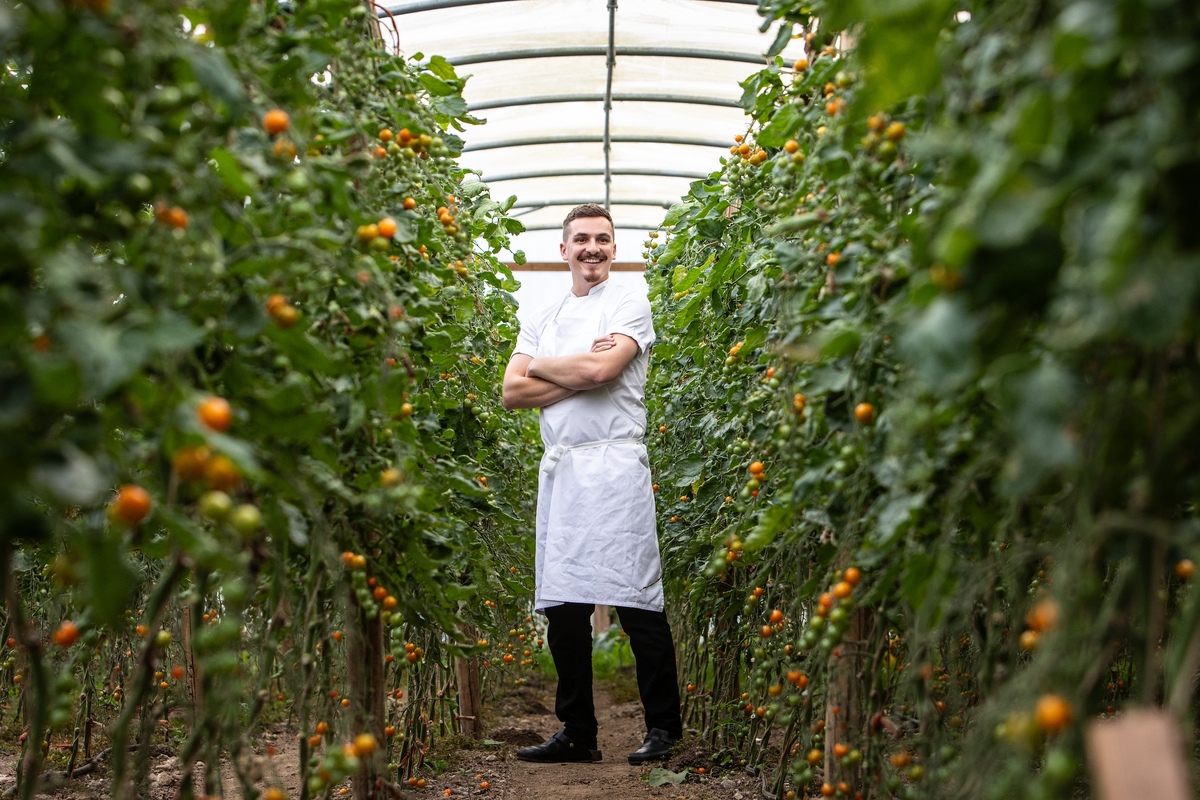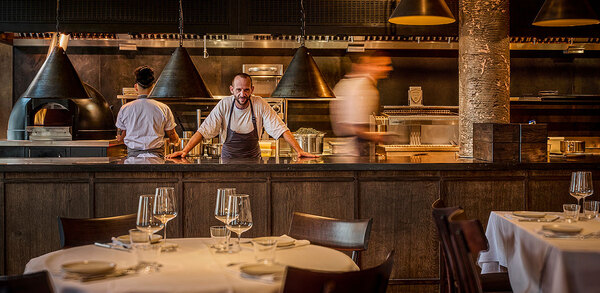Queen of the dessert
Claire Clark, former pastry supremo at the French Laundry in Napa Valley talks TV, MBE and pâtisseries to Joanna Wood
Can we kick-off by talking about your recent brief reunion with Thomas Keller at his phenomenally successful pop-up restaurant in Harrods? Of course - it was lovely working with Thomas and the French Laundry team again. They're my American family. He asked me if I'd organise and run the pastry team back in the summer - when I think he was still in talks with Harrods - so naturally I said "yes"! Although he brought over 26 people from America, he didn't bring anybody from the French Laundry pâtisserie team - only Laurie Morgan, who's his sous pâtissiere at Per Se - so it was my job to put a pastry team together.
That's a big responsibility - who did you get on board? Well, I had some great young chefs helping me. Louise Rigden, who I originally met after she was the highest scorer in pastry at the Academy of Culinary Arts Annual Awards scheme in 2008 - she was my right hand woman! (She has worked at Le Manoir aux Quat'Saisons, and she's also working with me at the Corinthia hotel in Whitehall, London, where I'm consulting two days a week at the moment). And a young guy, Matthew Williams, who was fabulous - he's from Boodles. He was only supposed to come for a few days and he stayed for the 10 days. He worked his little socks off! And I also had Sarah Crouchman from Rhubarb Food Design on the team.
How was the whole Harrods experience? Well, it was manic. We were in at 5am every day. And of course there were a few technical issues. The first day the air-con was too fierce - food was getting cold before going out. So it was turned down - then it was too hot! The usual stuff. It took two days to settle in.
It's not your first experience of pop-ups. You've done two pop-up restaurant/tea room concepts of your own - one last year in Harvey Nichol's in London; the other at Nigel Haworth's Fantastic Food Show at Blackburn Rovers' Ewood Park ground in June. Why are so many chefs doing pop-up restaurants now? The pop-up restaurant brings you, the chef, to the people. Both of mine connected my face and name with my product [the pâtisserie I put out at the restaurants] for the consumer/customer. So that's good for me, looking forward to setting up my business. They're hard work, but fun and a good way to give a little of yourself to those people who might not necessarily have known about you, or had the time to travel to where you previously worked. With Thomas at Harrods, it gave people who would never have a chance to go to his American restaurants the chance to see what he's all about.
Can you give us a bit more of an insight in to your own pop-ups? The Harvey Nicks pop-up was for two weeks in the autumn of 2010. We ran a tea menu and there was also a sales point for two months in the food hall next door, in the run-up to Christmas, with some Claire Clark branded packaged cakes, etc. I was totally blown away by how successful it was - I'd been out of the country for nearly five years, so to still have such a huge following was amazing. It really did what I wanted, which was to say "Hey, I'm back!" We did 500 teas in the two weeks.
And the Blackburn pop-up? It was over a weekend in the summer and was the brainchild of Nigel Haworth. I've been doing some consultancy work with Nigel and his pastry teams at Northcote, Blackburn Rovers and his pubs and he thought it was a good idea to put their skills to the test at the food festival. We did things like full afternoon tea and cream teas, cakes by the slice: traditional cakes like Victoria sandwich, carrot cake, éclairs, sticky date cake, strawberry band aux fruit (home-made rough puff pastry), chocolate fudge cake.
How successful was it? Very! Much busier than I thought it would be. We had a few days of flat-out prep work in the kitchens at Blackburn Rovers, which are gigantic and had all the kit we could possibly need - except a deck oven! And as I like to cook my éclair shells in a deck oven we ended up having to bake 300 at the Fishes pub before 9am on the first day of the festival. Actually, to be honest, the first day we weren't properly prepared and started service with 11 checks all on at the same time, at 11am! It was a bit of a fight to get 270 teas out on that first day. We ended up staying late, on in to the evening, on the first day and were able to do 560 covers on the second day - with the help of an expeditor from Northcote and a decent system in place. That's a lot of cake, scones and sandwiches!
This year, you also got an MBE as part of the Queen's Birthday Honours List in June. Do you feel any different now? And do you think it has a wider implication for the profile of pastry chefs in and outside of the industry? I feel just the same! - but with more responsibility to serve my industry. And, yes, I hope my MBE will help to inspire pastry chefs to do well and promote our profession. For me, the most meaningful and moving part of receiving the award were all the e-mails and telephone calls I had from pastry chefs thanking me for making a difference to their own lives and careers - some of whom barely spent any time at all with me, but who have already gone on to do wonderful things. It made the award very real for me. You don't think about how you influence people on a daily basis, just get on with doing your job as best you can.
Is handing on your knowledge and skills to younger chefs important to you? Teaching is one part of my job that is special and I love it. To be able to impart your knowledge and share it with others in the industry is so important. If you're a respected person in the industry, they DO look up to you, they DO have expectations of you. To give back to them and see them doing well is very important to me. To know that I've contributed a little bit - I get as much out of it as they do.
How do you feel about teaching via our filmed masterclass - showing www.catererandhotelkeeper.com users the finer points of choux pastry? It's a great way to share and impart your knowledge but I'm still a little nervous in front of a camera, even though we filmed it at Westminster Kingsway college which I am very familiar with. It's fine talking to a group of chefs - but it's a little different just to a camera. I don't know why, but it is! I'm getting better, though.
Where does choux pastry stand in the lexicon of pastry chef tools? It's huge. There are a few core things in our repertoire - and this is one. It's something that can be relatively simple and easy to make. But there are some really important steps and if you mess these up it's always going to go wrong. Pastry is a science. So if a recipe says boil it - boil it. If you're told to cook something out for five minutes, cook it out for five minutes. Everything happens for a reason. Follow the instructions.
You said you were getting better at filming. Have you been practising? Well, yes! I've been filming a series for Blackbird - a television production company. The series is called Chocolate Covered and it's made-up of 13 half-hour episodes. It captures some of our very own great chocolatiers and pastry chefs at work. It has been quite wonderful filming it: we've already filmed in Italy at Amedei and we're planning to go to France. We've been to the French Laundry, too, in the summer. I was so excited to be going "home" to see my French Laundry family. And you'll see me in the TV kitchen doing my thing as well.
When and where is it being shown? I'm not sure yet. Blackbird is in discussions with a couple of UK and international broadcasters. So it's a case of watch this space!
You mentioned the French Laundry again, where you were head pastry chef prior to returning to the UK about 18 months ago. It's one of the top pastry chef jobs in the world. Was it hard to give it up? Really hard. It's a special place - not just one of the top restaurants in the world. The people in the restaurant are a real family, a unit. It's like no other place I've ever worked in.
Why did you come back to England, then? It certainly wasn't for the weather! I really came back because I'd been at the French Laundry for four-and-a-half years and wanted to start to do something for myself. I've talked about it for years and years and years, so I just thought "stop procrastinating," and put the wheels in motion. It was a good enough reason to come back to the UK, to my home.
Getting a business off the ground can be a tricky and lengthy process. How are you doing? It has been difficult to find the right investor. I have had some very interesting meetings and spent a substantial amount of time with two really great financial advisers to get the business plan where it is today. A fantastic graphic designer, Mandy Sherliker, has put the concept into pictures and I feel it's in good shape. We are just waiting for the right opportunity with the right backers.
Is it still a Sex in the City-ish pâstisserie we're talking about in London? Sorry - I've learnt not to talk about things before they happen now! So no clues as to what, but when it happens you will certainly know about it! It's a very exciting time for pâtissiers on the high street at the moment and I'm more determined than ever to make my dream a reality. I have the skills and experience, so if anyone can do it, I feel I can.
Finally, what's your assessment of the state-of-play vis-à-vis home-grown pastry chefs? We have got some, honestly. And there are quite a few, like Louise and Matthew, coming through. But they do really need our support and encouragement. It's a hard world out there and it's easy to get despondent at times. Those of us who have already achieved something in our pastry chef world have got to be there to advise and support the younger chefs. I've had huge support and mentorship throughout my career - from John Huber, Ernest Bachmann, Thomas Keller and the Academy of Culinary Arts - and I'm more than happy to do the same for the next generation. It saddens me when people get secretive about their skills. It's not the way forward. We need to grow and expand our pâtisserie world as a whole, not just grow our skills as isolated individuals.
Choux basics
Choux pastry is a cross between a batter and a dough. If you follow the rules, it's easy to make. But, as with everything in pâtisserie, the rules are precise. Here are some crucial tips for success.
Once the flour has been added to the boiling water and butter, remember to cook the dough until it forms a ball in the centre of the pan.
The paste should be stirred or mixed lightly to let some, but not all, of the heat out before adding the eggs: this prevents them cooking.
Always beat the eggs together before adding them to the batter. Mix them in a little at a time: this will help ensure they are distributed evenly.
Oven temperature is very important. Choux pastry should be baked in a hot oven (200°C/gas mark 6). If the oven is too cool, the water in the dough will not evaporate quickly enough and the buns/éclairs will not form a well-risen bubble. As the heat evaporates the water and pushes the dough upwards, the surface sets quickly while the interior stays nearly liquid. It is important to lower the temperature after about 20 minutes, to dry out the interior of the bun/éclair.
Tips taken from Indulge: 100 Perfect Desserts by Claire Clark, Absolute Press ISBN 13:9781904573753
Chocolate Eclairs
ingredients
(Makes 24)
For the fondant icing 300g icing sugar
65ml water
1tbs liquid glucose
100g dark chocolate (70% cocoa solids), chopped
For the choux pastry 125ml water
50g unsalted butter, diced
1/2tsp salt
75g plain flour, sifted
1/2tsp caster sugar, sifted
2 medium eggs, lightly beaten
For the chocolate pastry cream 30g plain flour
30g cornflour
4 medium egg yolks
125g caster sugar
600ml milk
100g dark chocolate (70% cocoa), finely diced
Method
For the fondant icing: make this the day before. Cook the icing sugar, water and glucose over a low heat, stirring continuously, until it reaches 33°C. Remove from the heat and pour into a bowl. Cover the surface with clingfilm and leave to cool at room temperature.
For the choux pastry: Combine the water, butter and salt in a small pan and bring to the boil over a high heat. As soon as it comes to the boil, add the flour and sugar in one go, stirring constantly until it forms a ball. Reduce to a medium heat and keep stirring for one minute to dry out the mixture. Be careful not to let it dry out too much or the éclairs will crack when cooked.
Transfer the mixture to a bowl, stir briefly, then gradually work in beaten eggs, a little at a time, mixing well between each addition. Beat to a smooth paste with a wooden spoon. It should be thick enough to drop from the spoon when gently shaken.
Preheat oven to 200°C and grease two baking sheets with melted butter. Chill these before piping the éclairs - this stops the pastry sliding around. Pipe the pastry in lines of 12cm long éclairs using a 1cm plain nozzle, leaving a gap of 2.5cm between each one. Bake in the oven for 20 minutes, until golden brown and firm on the outside. Then turn the oven down to 180°C, continue to bake until the éclairs are firm and dry on the inside. Check by breaking one open. Remove from the oven and cool. Once cool, make two holes in either end of the base of each éclair (the tip of the piping nozzle is good for this) to use as a piping guide.
For the choux pastry cream: Sift the flour into a bowl. Add the cornflour and mix in the egg yolks and sugar to form a smooth paste. Bring the milk to the boil, then pour it on to the egg mixture and stir well. Return to a clean pan and whisk over a medium heat until it returns to the boil. Lower heat and simmer for one minute, to cook out the starch. Remove from the heat. Add the chocolate and once incorporated, transfer to a bowl, cover with clingfilm and cool. Once cream is cold, whisk until smooth, then pipe into the éclair shells using a 5mm plain nozzle.
To plate: finish off the fondant icing by melting chocolate over a pan of simmering water. Place the pre-made fondant mixture in a pan and gently heat to 32°C. Gradually stir-in melted chocolate. Finally, dip the top of each éclair in the warmed fondant. After dipping, hold the éclair at an angle pointing down towards the pan and remove any excess icing with your finger. Once the icing has firmed, serve.
Recipe taken from Indulge: 100 Perfect Desserts by Claire Clark, Absolute Press ISBN 13:9781904573753



















